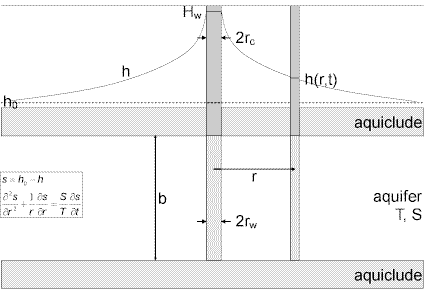Constant-Head Tests (Constant-Drawdown Tests)
by Glenn M. Duffield, President, HydroSOLVE, Inc.
What Is A Constant-Head Test?

A constant-head test (or constant-drawdown test) is a controlled field experiment in which head (drawdown) in a control well is maintained at a constant level while discharge is monitored through time at the contol well; water-level response (drawdown) may be measured in one or more nearby observation wells.
The goal of a constant-head test, as in any aquifer test, is to estimate hydraulic properties of an aquifer system. For the pumped aquifer, one seeks to determine transmissivity, hydraulic conductivity (horizontal and vertical) and storativity (storage coefficient). In layered systems, one also uses constant-head tests to estimate the properties of aquitards (vertical hydraulic conductivity and specific storage).

Typically, aquifer properties are estimated from a constant-head test by fitting mathematical models (type curves) to discharge data from the control well through a procedure known as curve matching (Figure 2).
Besides constant-head tests, other types of aquifer tests used to determine aquifer properties include pumping tests and slug tests.
Pumping Rate Measurements
Carefully monitoring and recording the pumping rate are essential for obtaining high-quality results from a constant-head test.
Measuring the flow rate during a constant-head test can be accomplished in a number of ways including the following:
- container and stopwatch
- in-line flowmeter
- orifice weir
- weir or flume

Disposal of Pumped Water
In the case of a constant-drawdown test in which water is withdrawn from an aquifer, care should be exercised in the disposal of the discharge water. First and foremost, be certain that you dispose of the water in accordance with any applicable laws and regulations.
Bear in mind the following considerations as you weigh discharge water disposal options:
- Avoid direct discharge of water on the ground surface if the water is likely to recharge the pumped aquifer (e.g., a shallow unconfined aquifer or karst aquifer with sinkholes).
- Discharge of water to a surface water feature such as a stream is a viable option if it is anticipated that the surface water body is hydraulically disconnected from the pumped aquifer or if it behaves as a constant-head boundary.
- Avoid adverse thermal, biological, water-quality, erosion or sediment mobilization impacts when discharging to groundwater or surface water and obtain appropriate discharge permits.